.
8.04.2016
THE COLOUR-CHANGING COMET


Comet 67P/Churyumov-Gerasimenko was seen changing colour and brightness by Rosetta’s Visible and InfraRed Thermal Imaging Spectrometer, VIRTIS, as more water-ice was exposed near its surface as it moved close to the Sun between August and November 2014.
In the three-month study period the comet moved from about 542 million km to 438 million km from the Sun, and the spacecraft-to-comet distance varied from about 100 km to 10 km, resulting in a range of illumination conditions and viewing geometries.
In general, the darkest portions of the comet, containing dry dust made out of a mixture of minerals and organics, reflect light at redder wavelengths, while active regions and the occasional ice-rich exposure is bluer.
The VIRTIS study shows that even in the first three months of study at the comet, global average changes are noticeable, with an overall trend of the comet becoming brighter and more water-ice-rich. This is particularly notable in the Imhotep region, which becomes overall bluer over time.
-
Rosetta’s comet has been seen changing colour and brightness in front of the ESA orbiter’s eyes, as the Sun’s heat strips away the older surface to reveal fresher material.
Rosetta’s Visible and InfraRed Thermal Imaging Spectrometer, VIRTIS, began to detect these changes in the sunlit parts of Comet 67P/Churyumov–Gerasimenko – mostly the northern hemisphere and equatorial regions – in the months immediately following the spacecraft’s arrival in August 2014.
A new paper, published in the journal Icarus, reports on the early findings of this study, up to November 2014, during which time Rosetta was operating between 100 km to within 10 km of the comet nucleus. At the same time, the comet itself moved along its orbit closer to the Sun, from about 542 million km to 438 million km.
VIRTIS monitored the changes in light reflected from the surface over a wide range of visible and infrared wavelengths, as an indicator of subtle changes in the composition of the comet’s outermost layer.
When it arrived, Rosetta found an extremely dark body, reflecting about 6% of the visible light falling on it. This is because the majority of the surface is covered with a layer of dark, dry, dust made out of mixture of minerals and organics.
Some surfaces are slightly brighter, some slightly darker, indicating differences in composition. Most of the surface is slightly reddened by organic-rich material, while the occasional ice-rich material shows up as somewhat bluer.
Even when Rosetta first rendezvoused with the comet far from the Sun, ices hidden below the surface were being gently warmed, sublimating into gas, and escaping, lifting some of the surface dust away and contributing to the comet’s coma and tail.
VIRTIS shows that as the ‘old’ dust layers were slowly ejected, fresher material was gradually exposed. This new surface was both more reflective, making the comet brighter, and richer in ice, resulting in bluer measurements.




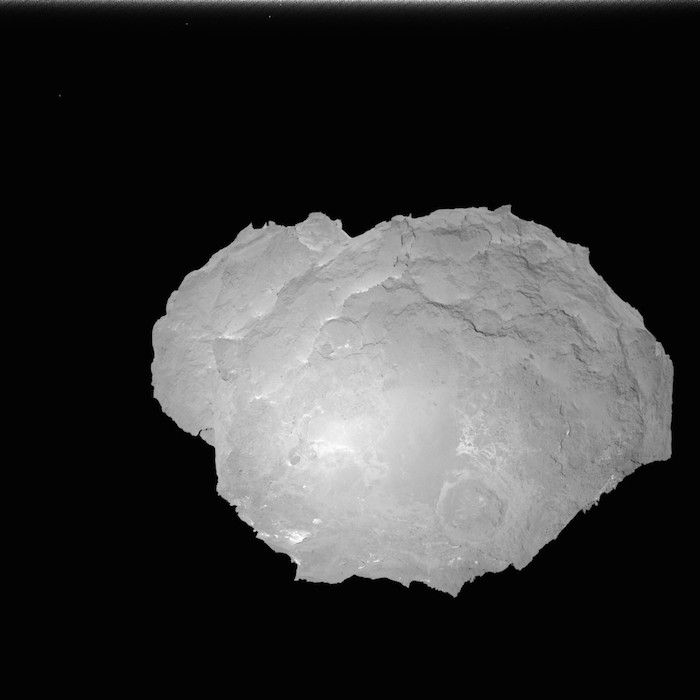


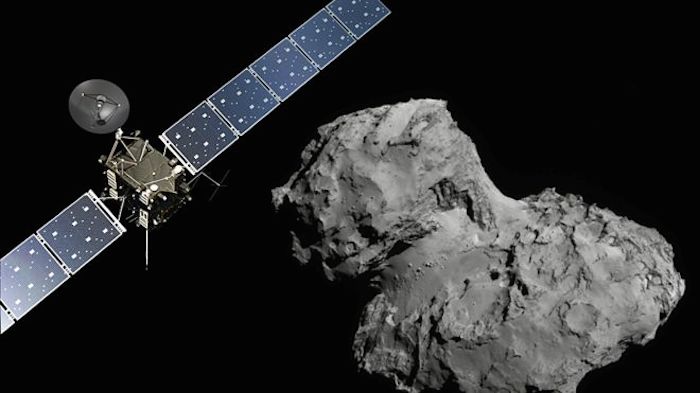
On average, the comet’s brightness changed by about 34%. In the Imhotep region, it increased from 6.4% to 9.7% over the three months of observations.
“The overall trend seems to be that there is an increasing water-ice abundance in the comet’s surface layers that results in a change in the observed spectral signatures. In that respect, it’s like the comet is changing colour in front of our eyes,” says Gianrico Filacchione, lead author of the study.
“This evolution is a direct consequence of the activity occurring on and immediately beneath the comet’s surface. The partial removal of the dust layer caused by the start of gaseous activity is the probable cause of the increasing abundance of water ice at the surface.”
“The surface properties are really dynamic, changing with the distance from the Sun and with the levels of comet activity,” adds Fabrizio Capaccioni, VIRTIS principal investigator.
“We’ve started analysing the subsequent datasets and can already see that the trend continues in the observations made beyond November 2014.”
“The evolution of surface properties with activity has never been observed by a cometary mission before and is a major science objective of the Rosetta mission,” says Matt Taylor, ESA’s Rosetta Project Scientist.
“It is great to see science papers being published directly addressing this topic and we’re looking forward to seeing how things have changed over the entire mission.”
Quelle: ESA
.
Update: 9.04.2016
.
SwRI-led team identifies clathrate ices in comet 67P
Studying comets provides clues to the early history of our solar system
-
San Antonio -- For decades, scientists have agreed that comets are mostly water ice, but what kind of ice -- amorphous or crystalline -- is still up for debate. Looking at data obtained by ESA's Rosetta spacecraft in the atmosphere, or coma, around comet 67P/Churyumov-Gerasimenko, scientists at Southwest Research Institute (SwRI) are seeing evidence of a crystalline form of ice called clathrates.
"The structure and phase of the ice is important because it tells us a lot about how and where the comet may have formed," says Dr. Adrienn Luspay-Kuti, a research scientist in SwRI's Space Science and Engineering Division. She is the lead author of a paper titled "The presence of clathrates in comet 67P/Churyumov-Gerasimenko" published in the April 8 issue of the journal Science Advances. "If the building blocks of 67P were predominantly crystalline ices and clathrates, then 67P likely agglomerated from chunks of ice closer to the Sun. The protosolar nebula closer to the Sun experienced higher temperatures and more turbulence where crystalline ices could form as the nebula cooled. More pristine amorphous ices likely dominated the colder outskirts of the rotating disk of dust and gas that surrounds the core of a developing solar system."
Amorphous water ice efficiently traps large amounts of volatile compounds, which are released simultaneously upon warming. Water clathrates are crystalline structures containing gas molecules. The volatiles locked inside the water actually create the stable clathrate structure. These structures release gases at characteristic temperatures, dependent on the gas-phase volatile locked inside the clathrate. Luspay-Kuti led an international team of cometary experts that interpreted Rosetta spacecraft data, and found that the observed outgassing pattern indicates the nucleus of 67P contains clathrates.
"Without direct sampling of the nucleus interior, evaluating the composition of the coma provides the best clues about the ice structure and, as a result, the possible origin of cometary nuclei," said Luspay-Kuti. "Thought to closely reflect the composition of the building blocks of our solar system, comets carry important information about the prevalent conditions in the solar nebula before and after planet formation. These small icy bodies help us understand the big picture."
The multi-institute team of cometary scientists analyzed mass spectrometer data from the southern region of 67P from September to October 2014, before equinox. 67P is a Jupiter family comet thought to originate from the Kuiper Belt. Scientists are comparing these new data with data from the flyby of Hartley 2 -- considered cometary kin in family and origin to 67P -- and finding correlations. If these comets formed closer to the Sun than originally thought, these data could help refine solar system formation models.
###
This research was supported by NASA's Jet Propulsion Laboratory, Cornell University, the French National Research Agency, Centre National d'Études Spatiales, and the James Webb Space Telescope project. Rosetta is an ESA mission with contributions from its member states and NASA. Airbus Defense and Space built the Rosetta spacecraft. JPL manages the U.S. contribution of the Rosetta mission for NASA's Science Mission Directorate in Washington, D.C., under a contract with the California Institute of Technology.
Quelle: AAAS
.
COMETWATCH 4 APRIL
This week Rosetta has been moving back towards Comet 67P/Churyumov-Gerasimenko again following its far excursion in the anti-sunward direction to study the wider coma, tail and plasma environment.
.

Rosetta NAVCAM image of Comet 67P/C-G taken on 4 April 2016 from a distance of 338 km. The image scale is 28.8 m/pixel and the image measures 29.5 km across. Credits: ESA/Rosetta/NavCam – CC BY-SA IGO 3.0
The spacecraft reached ~1000 km on 30 March and is now less than 100 km again. Today’s CometWatch image was taken on the inbound leg of the journey, on 4 April, from a distance of 338 km.
Even at this distance, a number of the comet’s regions can be picked out: notably the flat surface of Khepry to the top right of the large lobe with Aker ‘below’ and Babi to the left in this orientation. On the small lobe, Hatmehit is in shadow to the lower right with parts of Bastet and Ma’at above and to the left.
.

OSIRIS narrow-angle camera image taken on 29 March 2016, when Rosetta was 820 km from Comet 67P/Churyumov–Gerasimenko. The scale is 14.9 m/pixel. Credits: ESA/Rosetta/MPS for OSIRIS Team MPS/UPD/LAM/IAA/SSO/INTA/UPM/DASP/IDA
.
Earlier this week we also saw views from the far excursion through Rosetta’s OSIRIS narrow- and wide-angle cameras, from distances of 820 km on the outward journey (above), and 442.3 km on the return journey (right), respectively.
The spacecraft continues to approach the comet and over the weekend it is set to carry out a zero phase flyby at around 30 km altitude.
The original NAVCAM image is provided below:
ESA_Rosetta_NAVCAM_20160404
.

---
COMETWATCH 10 APRIL
After a far excursion to explore the tail of Comet 67P/Churyumov-Gerasimenko, Rosetta is now back to closer distances from the comet nucleus. This week's CometWatch image was obtained with Rosetta's NAVCAM at 01:39 UTC on 10 April 2016, 31.4 km away.
.

Enhanced NAVCAM image of Comet 67P/C-G taken on 10 April 2016, 31.4 km from the comet nucleus. The scale is 2.7 m/pixel and the image measures 2.7 km across. Credits: ESA/Rosetta/NAVCAM – CC BY-SA IGO 3.0
-
Enhanced NAVCAM image of Comet 67P/C-G taken on 10 April 2016, 31.4 km from the comet nucleus. The scale is 2.7 m/pixel and the image measures 2.7 km across. Credits: ESA/Rosetta/NAVCAM – CC BY-SA IGO 3.0
On the night between 9 and 10 April 2016, the spacecraft performed a special flyby, 30 km from the nucleus and with a phase angle very close to zero degrees.
The phase angle is measured between the direction of the sunlight illuminating the nucleus and that of the light reflected by the nucleus and caught by Rosetta. A near-zero phase angle means that these two directions are very close to one another, which happens when the spacecraft is flying exactly between the Sun and the comet.
In this configuration, Rosetta could see the sunlight hitting the nucleus at right angles, and therefore observed very little shadows on the surface.
The CometWatch image was taken shortly after the closest approach on this flyby, at a phase angle of 11.7 degrees.
The image shows mostly the small comet lobe and 'neck' region, with the smooth and bouldered terrains of Hapi, along the comet's neck, visible in the top right corner. A hint of the large lobe can also be seen in the top right corner.
Moving towards the lower left, portions of the rough Hathor region are visible, as well as parts of Ma'at farther on the left. The linear and almost parallel features visible on the right, instead, are part of Bastet.
The three-dimensional aspect of the nucleus and of its characteristic surface features is almost lost in this low phase-angle view, due to the scarcity of shadows. This is even more evident in the image captured by Rosetta’s OSIRIS wide-angle camera at 00:57 UTC on 10 April, about one hour before the NAVCAM view, at a phase angle of 0.9 degrees.
.

OSIRIS wide-angle camera image taken on 10 April 2016, when Rosetta was 29.3 km from Comet 67P/Churyumov–Gerasimenko. The scale is 2.86 m/pixel. Credits: ESA/Rosetta/MPS for OSIRIS Team MPS/UPD/LAM/IAA/SSO/INTA/UPM/DASP/IDA
In this image, the large lobe is in the foreground and the small lobe in the background, on the left. The view on the large lobe is dominated by the flat landscape of the Imhotep region, with Khepry on its lower left, Aten on the upper left and Ash on the upper right.
Parts of Imhotep, Khepry and Ash are also featured in this OSIRIS narrow-angle camera image, taken somewhat earlier, at 00:10 UTC on 10 April, at a phase angle of two degrees.
.

OSIRIS narrow-angle camera image taken on 10 April 2016, when Rosetta was 30.1 km from Comet 67P/Churyumov–Gerasimenko. The scale is 0.55 m/pixel. Credits: ESA/Rosetta/MPS for OSIRIS Team MPS/UPD/LAM/IAA/SSO/INTA/UPM/DASP/IDA
With hardly any shadows cast on the surface, the morphological differences between the three regions do not markedly appear. However, we can still recognise the smooth terrains of Imhotep in the right half of the image, while the cliff in the upper left corner is part of Ash and the rougher areas at the centre and towards the lower left belong to Khepry.
The original NAVCAM image is provided below.
.

Quelle: ESA
-
Update: 1.07.2016
.
Rosetta comet probe given termination date

The Rosetta probe will be crash-landed on Comet 67P on Friday 30 September, the European Space Agency has confirmed.
The manoeuvre, which is expected to destroy the satellite, will bring to an end two years of investigations at the 4km-wide icy dirt-ball.
Flight controllers plan to have the cameras taking and relaying pictures during the final descent.
Sensors that "sniff" the chemical environment will also be switched on.
All other instruments will likely be off.
Flight dynamics experts have still to work out the fine details, but Rosetta will be put into a tight ellipse around the comet and commanded to drop its periapsis (lowest pass) progressively. A final burn will then put the satellite on a collision course with the duck-shaped object.
Mission managers have previously talked about bringing Rosetta down in a place dubbed "Agilkia" - the location originally chosen to land its surface robot, Philae, in November 2014.
In the event, Philae bounced a kilometre away, but Agilkia's relatively flat terrain is an attractive option still, although other targets are being studied.
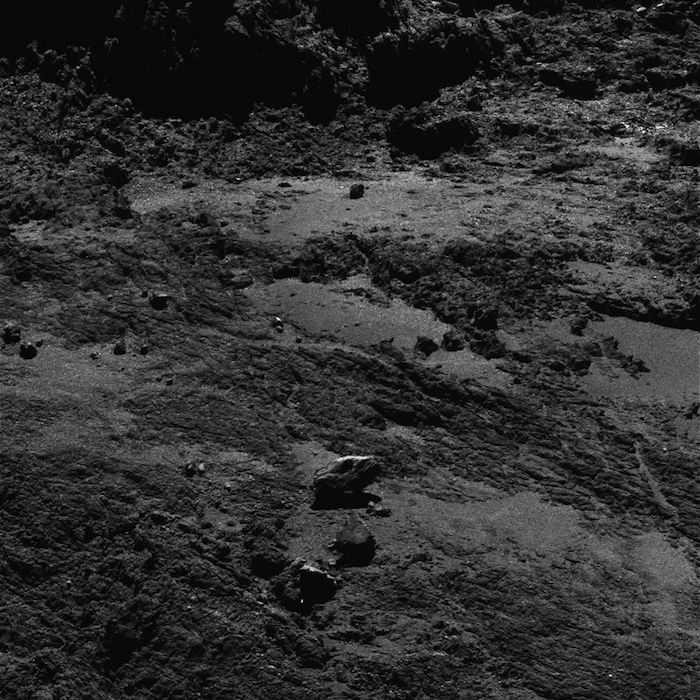



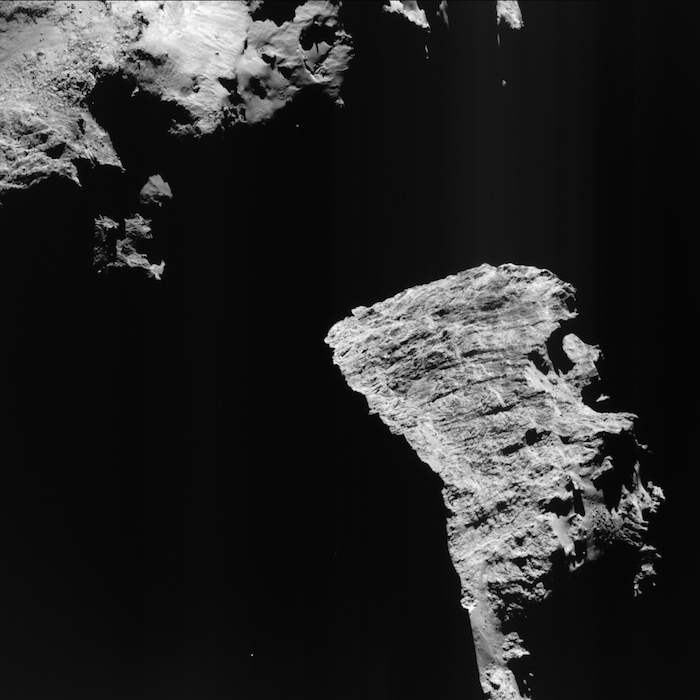
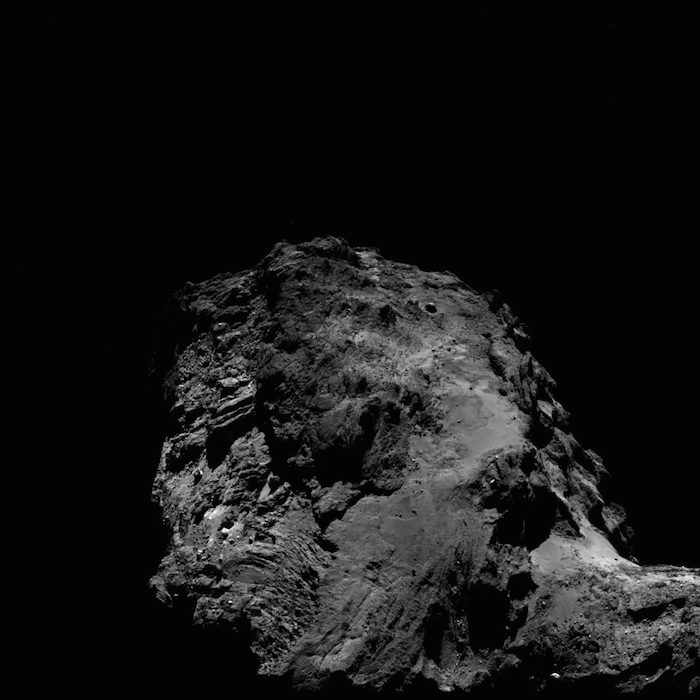
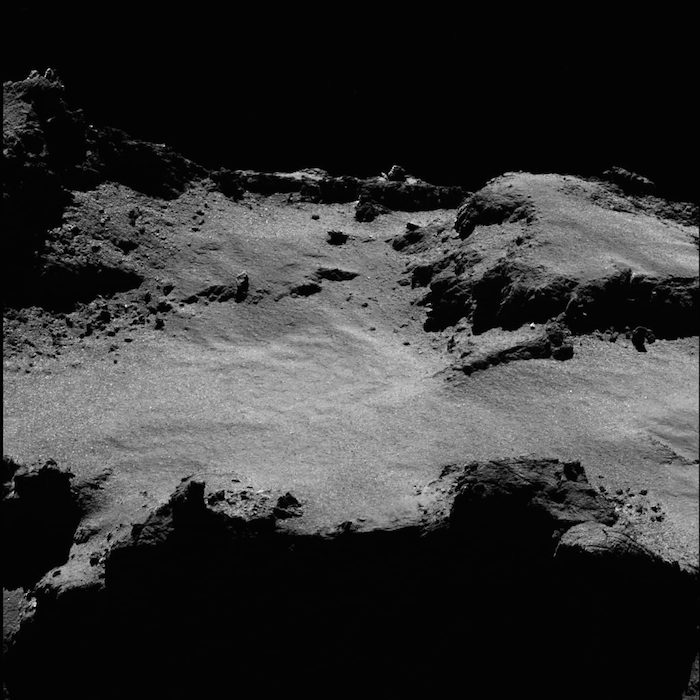






Having swept around the Sun last August, Comet 67P is currently on a trajectory that is taking it away from the inner Solar System towards the orbit of Jupiter.
Today, the probe is nearly half a billion km from the Sun.
This means the amount of light falling on Rosetta's solar panels is gradually diminishing; and, as a consequence, it has less power day by day to run its instruments and sub-systems.
Engineers would soon have to put the satellite into hibernation mode if they wanted to use it long term - during 67P's next encounter with the Sun in a few years' time.
But having already spent 12 years in space, battling huge temperature swings and damaging radiation, not to mention a much-reduced fuel load - there is little confidence Rosetta will still be operable so far into the future.
The crash-landing on the other hand offers the opportunity to get some very close-in science to complement the more distant remote sensing it has been doing.
Controllers will try to maintain contact with the satellite for as long as possible during the final descent.
Much will depend on how well Rosetta copes with the dusty environment around the comet.
Recent months have seen several occasions when the probe's navigation equipment, which tracks the stars to define a position in space, has got confused in the maelstrom of particles emanating from 67P's surface.
This has tripped the satellite into a "safe mode" that shuts down all non-essential operations, including instrument observations.
Rosetta will need to be commanded not to do this in the minutes before impact.
Crash-landing has become a common way to end the missions of planetary probes.
Most have been very high-velocity impacts, but a few, like the one Rosetta will attempt, have been walking-pace touchdowns.
In 2001, the US space agency's Near Shoemaker probe put down on the asteroid Eros so gently that it continued to work for a further two weeks at the surface before engineers eventually determined to terminate communications.
This will not be the case with Rosetta, however. Controllers are expected to program an auto shutoff, which will be triggered at the moment the satellite hits 67P.
Even if by chance its antenna were to survive the crush, Rosetta will not be calling home.
Quelle: BBC
-
Update: 17.45 MESZ
.
Rosetta wird ihre Mission am 30. September 2016 mit einer kontrollierten Landung auf die Oberfläche ihres Kometen abschließen.
-
Die Mission erreicht aufgrund der immer größeren Entfernung des Raumfahrzeugs von der Sonne und Erde ihr Ende. Die Sonde bewegt sich in Richtung Jupiterorbit. Daher nimmt die für den Betrieb des Raumfahrzeugs und der Instrumente erforderliche Sonnenenergie aber auch die verfügbare Bandbreite zur Übermittlung der Wissenschaftsdaten zur Erde stetig ab.
In Verbindung mit dem steigenden Alter des Raumfahrzeugs sowie der Nutzlast, die mehr als 12 Jahre lang die harschen Umweltbedingungen im Weltraum überdauert haben – nicht nur die letzten beiden Jahre in der Nähe eines staubigen Kometen –, bedeutet dies, dass Rosetta das Ende ihres “natürlichen Lebens” erreicht.
Im Unterschied zu 2011, als Rosetta für die am weitesten entfernte Etappe ihrer Reise über 31 Monate lang in eine Art Winterschlaf versetzt wurde, fliegt sie dieses Mal Seite an Seite mit dem Kometen. Die größte Entfernung des Kometen 67P/Tschurjumov-Gerassimenko von der Sonne (mehr als 850 Millionen km) ist so weit, wie Rosetta nie zuvor gereist ist. Leider steht an diesem entlegensten Punkt der Reise nicht mehr genügend Energie zur Verfügung, um Rosetta Heizungen zu betreiben und so für ein Überleben der Sonde zu sorgen.
Statt sich der Gefahr einer weitaus längeren Überwinterung auszusetzen, die die Sonde vermutlich nicht überstehen würde, und nach Beratungen mit dem Wissenschaftsteam von Rosetta im Jahr 2014, wurde beschlossen, dass Rosetta ihrem Landemodul Philae auf die Kometenoberfläche folgt.
Die letzten Stunden des Abstiegs bieten Rosetta die einmalige Möglichkeit, zahlreiche Messwerte zu erfassen, unter anderem auch extrem hochauflösende Bilder. Solche Nahaufnahmen, die nur bei diesem glorreichen Abschluss der Mission zu machen sind, setzen den wissenschaftlichen Erkenntnissen der Sonde zweifelsfrei die Krone auf.
Die Kommunikation mit dem Orbiter wird jedoch bei Erreichen der Kometenoberfläche enden, wenn er seinen Betrieb einstellt.
“Wir werden versuchen, noch so viele Untersuchungen wie möglich herauszuziehen, bevor uns die Sonnenenergie ausgeht”, erzählt Matt Taylor, Rosetta Projektwissenschaftler der ESA. “Der 30. September markiert das Ende des Betriebs der Raumsonde, jedoch auch den Beginn der Phase, in der sich die Teams voll und ganz auf die Wissenschaft fokussieren. Deswegen wurde die Rosetta Mission gestartet und es liegen einige Jahre Arbeit vor uns, bis wir all ihre Daten sorgfältig ausgewertet haben.”
Das Kontrollteam von Rosetta wird die Flugbahn im August, vor dem großen Finale, so anpassen, dass sie eine Reihe elliptischer Orbits fliegt und sich dabei langsam dem Kometen annähert.
“Die Planung dieser Phase ist tatsächlich wesentlich komplexer als es bei der Landung von Philae der Fall war”, meint Sylvain Lodiot, Rosetta Spacecraft Operations Manager bei der ESA. “Die letzten sechs Wochen werden ganz besonders spannend, weil wir dann exzentrische Orbits um den Kometen fliegen – und das ist in vielerlei Hinsicht wesentlich riskanter als der eigentliche Abstieg.
“Je näher wir dem Kometen kommen, desto stärker wirkt sich seine ungleichmäßige Schwerkraft aus, weswegen wir die Flugbahn intensiver kontrollieren müssen. Dafür sind zahlreiche Manöver erforderlich – unsere Planungszyklen werden dann sehr viel kurzfristiger ausgeführt.”
An den letzten Tagen der Mission wird eine letzte Flugbahnänderung in etwa 20 km Abstand vom Kometen, circa 12 Stunden vor dem Aufsetzen, eine Reihe von Manövern abschließen und die Raumsonde auf ihren letzten Weg hinunter zum Kometen bringen.
Wo Rosetta landen soll, wird weiterhin diskutiert, da das Operationsteam und die Wissenschaftler die verschiedenen Parameter mit zahlreichen unterschiedlichen Flugbahnen abstimmen müssen.
Generell wird jedoch erwartet, dass die Landung mit etwa 50 cm/s erfolgen soll, das ist etwa halb so schnell, wie die Landegeschwindigkeit von Philae im November 2014.
Die an den Tagen davor hochgeladenen Befehle stellen automatisch sicher, dass sowohl die Transmitter als auch alle Einheiten und Instrumente zur Fluglage und Kontrolle des Orbits mit der Landung ausgeschaltet werden, um die Entsorgungsanforderungen für Raumfahrzeuge zu erfüllen.
In jedem Fall wird die Hochleistungsantenne von Rosetta nach der Landung nicht mehr auf die Erde gerichtet sein, wodurch eine Kommunikation praktisch unmöglich wird.
Zwischenzeitlich laufen die Forschungen weiter, wie sonst auch, obwohl zahlreiche Risiken vorprogrammiert sind. Vergangenen Monat verbrachte das Raumfahrzeug einige Zeit in einem ‘sicheren Modus’, als es nur 5 km vom Kometen entfernt war und Staub das Navigationssystem beeinträchtigte. Rosetta hat sich dann wieder erholt, aber das Missionsteam kann nicht ausschließen, dass ein solcher Zustand zum Ende der Mission hin erneut auftritt.
“Obwohl wir unsere Arbeit bestmöglich erledigen, damit Rosetta bis dahin unversehrt bleibt, wissen wir aufgrund unserer Erfahrungen aus den vergangenen zwei Jahren beim Kometen, dass vieles nicht so läuft, wie geplant und – wie immer – müssen wir auf das Unerwartete vorbereitet sein”, räumt Patrick Martin ein, Rosetta-Missionsleiter bei der ESA.
“Dies ist die ultimative Herausforderung für unsere Teams und für unser Raumfahrzeug, und ein sehr passendes Ende für die unglaubliche und erfolgreiche Rosetta Mission.”
Quelle: ESA
-
Update: 5.07.2016
.

ID NAC_2016-07-03T11.09.52.166Z_ID10_1397549001_F22
Date taken 2016-07-03T11:11:19.201 (UTC)
Camera Narrow Angle Camera
Filter FFocus_Vis (-) / Orange (649 nm)
Exposure time 0.114 s
Pixel resolution 0.16 m/px at 67P/CG
Processing level Raw
Distance Rosetta ↔ 67P/CG 9.115 km
Distance 67P/CG ↔ Sun 497355104 km 3.324614 AU
Distance Rosetta ↔ Earth 523909280 km 3.502117 AU
Credit: ESA/Rosetta/MPS for OSIRIS Team MPS/UPD/LAM/IAA/SSO/INTA/UPM/DASP/IDA
Quelle: ESA
-
Update: 16.07.2016
.
COMETWATCH 25 JUNE
This week's CometWatch image was taken with Rosetta's NAVCAM on 25 June 2016, when the spacecraft was 16.7 km from the nucleus of Comet 67P/Churyumov-Gerasimenko.
.

Enhanced NAVCAM image of Comet 67P/C-G taken on 25 June 2016, 16.7 km from the nucleus. The scale is 1.4 m/pixel and the image measures 1.5 km across. Credits: ESA/Rosetta/NAVCAM – CC BY-SA IGO 3.0
-
The image shows a portion of the large comet lobe, with the neck region and a hint of the small lobe on the upper right.
Dominated by the smooth terrains of Anubis, on the large lobe, this scene reveals the many boulders scattered across this region, as well as a number of surface features visible in the dust cover. A similar view of this area, taken from a comparable distance but different perspective, was featured in CometWatch 1 May.
In the central left portion of the image, towards the upper edge of the nucleus, some elevated, shadow-casting structures mark the boundary between Anubis and Seth. Parts of the more complex Atum region are visible in the bottom part of the image, exhibiting a number of linear features especially towards the lower right corner, close to the boundary with the neighbouring Geb region.
On the upper right, along the neck, the smooth region of Hapi, covered in dust and plenty of boulders, guides the eye towards the rougher Anuket, partly cast in shadow.
Another image, taken on the same day with Rosetta's OSIRIS narrow-angle camera, shows a detailed view of an entirely different portion of the large comet lobe, at the meeting point between the regions of Khepry (upper left), Imhotep (right) and Bes (bottom).
.

OSIRIS narrow-angle camera image taken on 25 June 2016, when Rosetta was 17.9 km from Comet 67P/C-G. The scale is 0.31 m/pixel and the image measures about 630 m. Credits: ESA/Rosetta/MPS for OSIRIS Team MPS/UPD/LAM/IAA/SSO/INTA/UPM/DASP/IDA
The original NAVCAM image is provided below.
.

-
COMETWATCH 30 JUNE
Today's CometWatch entry, also featured as ESA Space Science Image of the Week, is an image of Comet 67P/Churyumov-Gerasimenko taken with Rosetta's navigation camera (NAVCAM) on 30 June 2016, from a distance of 25.8 km.
.

Enhanced NAVCAM image of Comet 67P/C-G taken on 30 June 2016, 25.8 km from the nucleus. The scale is 2.2 m/pixel and the image measures 2.3 km across. The faint vertical striping effect is an image artifact. Credits: ESA/Rosetta/NAVCAM – CC BY-SA IGO 3.0
-
Depicted in the lower right part of the image is the region Hathor, a very intriguing portion of the small comet lobe, where the head declines steeply towards the neck and body of the comet.
This view shows a good fraction of the 900-m high cliff that forms Hathor, with marked linear features crossing the region from left to right. Perpendicular to these, additional streaks and even small terraces can be seen. Beyond the cliff of Hathor, on the right, are hints of the Ma'at region.
In the upper right corner, smoother patches of the large comet lobe are visible, covered in dust and boulders. The large lobe casts its shadow on the comet's neck, which separates the two lobes and is hidden from view in this image.
Meanwhile, Rosetta's OSIRIS wide-angle camera obtained this stunning image of a different portion of the comet on 2 July, when the spacecraft was 14.5 km from the nucleus.
.

OSIRIS wide-angle camera image taken on 2 July 2016, when Rosetta was 14.5 km from Comet 67P/C-G. The scale is 1.38 m/pixel and the image measures about 2.8 km. Credits: ESA/Rosetta/MPS for OSIRIS Team MPS/UPD/LAM/IAA/SSO/INTA/UPM/DASP/IDA
-
The image shows most of the large comet lobe, with the Khonsu, Atum and Anubis regions well in sight, from left to right, and hints of Seth towards the right edge. In the lower right corner, the smooth region of Hapi is visible, on the neck, leading towards the rougher Anuket.
Another striking image, featuring smooth-covered terrains in the Babi region, on the large comet lobe, was taken with the OSIRIS narrow-angle camera on 3 July, when Rosetta was about 11 km from the nucleus.
.

OSIRIS narrow-angle camera image taken on 3 July 2016, when Rosetta was 11.2 km from Comet 67P/C-G. The scale is 0.20 m/pixel and the image measures about 410 m. Credits: ESA/Rosetta/MPS for OSIRIS Team MPS/UPD/LAM/IAA/SSO/INTA/UPM/DASP/IDA
-
Currently, Rosetta is on a 27 km x 9 km elliptical orbit around the nucleus; this weekend, it will move to a less eccentric, 9 km x 10 km orbit, ahead of entering the end-of-mission orbit. The mission will continue its close-up investigation of the comet environment until the grand finale, a controlled descent of the spacecraft to the surface of the comet on 30 September.
The original NAVCAM image is provided below.
.

Quelle: ESA
.
COMETWATCH 9 JULY
This week's CometWatch image was taken with Rosetta's NAVCAM on 9 July 2016, when the spacecraft was 11.7 km from the nucleus of Comet 67P/Churyumov-Gerasimenko.
.

Enhanced NAVCAM image of Comet 67P/C-G taken on 9 July 2016, 11.7 km from the nucleus. The scale is 1 m/pixel and the image measures about 1 km. Credits: ESA/Rosetta/NAVCAM – CC BY-SA IGO 3.0
-
This close-up view shows a portion of the Khonsu region on the larger of the two comet lobes. Khonsu is part of the southern hemisphere of 67P/C-G.
The image reveals a variety of fractured and smooth terrains, with a great number of boulders of all sizes, including several large ones. It also includes a three-layered structure with a balancing boulder on top, which was also portrayed in previous images, for example the NAVCAM view featured as CometWatch 13 June, which shows the same region but from a broader perspective.
Meanwhile, a view of Comet 67P/C-G from Rosetta's OSIRIS wide-angle camera was published on the OSIRIS Image of the Day website earlier this week.
.

OSIRIS wide-angle camera image taken on 4 July 2016, when Rosetta was 13.3 km from Comet 67P/C-G. The scale is 1.28 m/pixel and the image measures 2.6 km. To preserve the correct orientation of the comet, the image has been flipped horizontally with respect to the one originally published on the OSIRIS Image of the Day website. Credits: ESA/Rosetta/MPS for OSIRIS Team MPS/UPD/LAM/IAA/SSO/INTA/UPM/DASP/IDA
-
The image, taken on 4 July from a distance of 13.3 km, shows a large portion of the large comet lobe, highlighting the circular features of the Seth and Ash regions and with hints of the complex terrains of Atum towards the right.
In the top left part of the frame, on the comet's neck, the dust covered landscape of Hapi is portrayed just below the slopes of the rougher Anuket region, while the cliffs of Hathor are cast in shadow on the left.
A similar and somewhat complementing view, also taken with the OSIRIS wide-angle camera but on 11 July, some 15 km from the nucleus, was published earlier today.
.

OSIRIS wide-angle camera image taken on 11 July 2016, when Rosetta was 14.9 km from Comet 67P/C-G. The scale is 1.38 m/pixel and the image measures 2.8 km. Credits: ESA/Rosetta/MPS for OSIRIS Team MPS/UPD/LAM/IAA/SSO/INTA/UPM/DASP/IDA
-
On the small lobe, in the top part of the image, are portions of Serqet (left) and Ma'at (right), while on the large lobe, in the lower left part of the frame, are views of Seth and Ash. In the central part of the image, the regions on and close to the neck – Hapi, Hathor and Anuket – are cast in dark shadows.
Another view, taken with the OSIRIS narrow-angle camera on 10 July from a distance of 9.5 km, provides a detailed view of a different portion of the large comet lobe, with sights of the Khepry and Aker regions.
.

OSIRIS narrow-angle camera image taken on 10 July 2016, when Rosetta was 9.5 km from Comet 67P/C-G. The scale is 0.31 m/pixel and the image measures about 630 m. Credits: ESA/Rosetta/MPS for OSIRIS Team MPS/UPD/LAM/IAA/SSO/INTA/UPM/DASP/IDA
The original NAVCAM image is provided below.
.

Quelle: ESA
5748 Views
